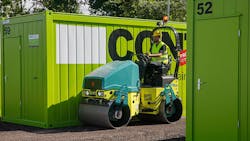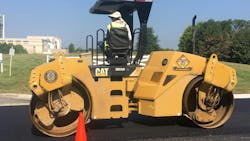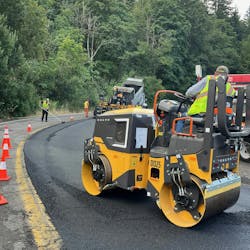Tandem (double drum) vibratory roller manufacturers don’t change models quite at the pace that earthmoving OEMs do, but there have been notable developments since the last time Construction Equipment covered the category.
There are now electric models to choose from on the smaller end of the spectrum, a player in the market reviving an old name (JCB Vibromax), and a key safety and technology choice.
First, some managers will have to make the call on tandems versus combination or single drum rollers.
“Due to their dual-drum design, these rollers can cover twice the area in a single pass—speeding up project completion while decreasing labor costs,” says Dustin Eusabio, director of strategic partnerships & general accounts, BigRentz. “Because they feature two large drums, one in the front and one in the rear, that are designed to compact surfaces both ahead of and behind of their machine simultaneously, they give greater efficiency and power than conventional machines with tires.
“However, depending on project requirements, this lack of tires could benefit or detract,” Eusabio says.
Eusabio lists jobs more suited to single drum rollers: leveling ground for sidewalks, driveways, and building foundations; compacting soil; paving smaller roads; and projects that require extra mobility and precision, such as working in tight spaces or making sharp turns.
For tandem rollers, he cites flattening heavy areas such as subgrades and subbase layers on roads, highway paving where efficiency and speed are important to return the area to traffic, and larger-scale projects needing multiple passes with a single roller for completion like thicker asphalt or dense soil.
“Consider all of your project requirements carefully—such as type of surface, compaction depth, and maneuverability needs—when choosing between single drum roller and double drum roller,” Eusabio says.
What are some choices in the latest tandem rollers?
“Think carefully about how wide a drum you require relative to the size and scope of the area you need to compact,” Eusabio says. “Wider drums will enable you to cover more ground quickly, speeding up completion. And make sure your drum roller has enough weight and power to handle the materials or surfaces that require compacting.”
Electric asphalt compactors
For smaller asphalt projects, managers now have the ability to choose electric tandem rollers from several manufacturers, with more on the way. They do offer some unique benefits.
Wirtgen’s Hamm brand, no stranger to technological innovation, now offers two electric tandem rollers it says have the same compaction power as their diesel equivalents.
The 5,512-pound HD 10e delivers about 8,070 lb.-ft. of centrifugal force; the 5,953-pound HD 12e about 9,150 lb.-ft. Drum widths are 39.4 inches and 47.2 inches, respectively.
The rollers are powered by a 48V Li-ion battery with 23.4 kWh. Charging from 0% to 100% takes approximately 4 hours on 220V, the company says.
The Hammtronic control system monitors and controls the components of the electric rollers. An automatic electric motor stop deactivates all functions when the machine is idling, saving battery capacity. In ECO mode, the control limits the working speed. The steering control also helps to conserve energy: In the parking position, it uses no energy at all, Hamm says. The steering motor does not switch on until the electric driving lever is actuated.
BOMAG’s 2.5-ton BW 100 AD e-5 tandem vibratory roller is battery-electric powered, with a 39.4-inch rolling width.
Similar to the diesel-powered BW 100 AD-5, the electric roller allows for individual vibration control to both drums, and vibration actuation is controlled through the travel lever.
It offers two vibration frequencies of 3,900 and 3,360 vpm with a single amplitude of 0.20 inch, generating 7,194 and 5,395 pounds centrifugal force.
The 48V system has 25-kWh, lithium-ion batteries. Its recuperative system works during braking, converting mechanical energy back into electrical energy. The roller offers flexible plug and charging options.
How to choose a roller based on drum width
The e-Performance system is equipped with two electric motors: one dedicated to travel and the other for steering and vibration. A 26.8-horsepower electric motor propels the front and rear driven drums at working speeds of 0-3.1 mph and travel speeds reaching 6.2 mph.
When traveling, the roller only uses one motor to conserve energy. With no warm-up necessary, the roller is ready for work at the push of the ignition button.
The double-drum Volvo DD25 Electric is designed to meet or exceed the performance level of its diesel equivalent. For instance, its 24 kW of peak available power is 30% more than the conventional DD25B compactor, which results in a more responsive machine in terms of speed and vibrations, according to Volvo.
It also performs better on grade thanks to the size of its components and better at high elevations when compared to a diesel machine, which loses power as altitude increases.
Dynapac is also producing electric double drum rollers. No doubt more, and larger, electric tandem vibratory rollers from multiple manufacturers are coming.
What safety technology is on asphalt rollers?
On the tech and safety side, Sakai has introduced auto brake assist system technology for rollers. Called “Guardman,” it addresses a problem in the paving train.
Proximity warning systems for paving construction sites do not consider whether workers are already aware of hazards prior to issuing warnings. Repeated alarms and other audio notifications can become distracting and cause alarm fatigue. There is also the possibility workers may ignore or simply disable the warnings, increasing their risk of injury.
Guardman technology is designed to take human response time out of stopping. Even an incursion as small as a golf ball triggers the Guardman system technology to stop the roller immediately upon detecting an obstacle, no matter if the roller’s operator notices the object or not, Sakai says.
The system detects personnel, equipment, or objects in front of or behind the compactor—and automatically brakes when a collision is imminent. The operator does not need to intervene.
According to the company, other compaction machines in the market carry rear-incursion detection only, in part because smaller rollers offer minimally acceptable front visibility. The Guardman smart detection system means that the roller will brake in an emergency while moving forward, such as before hitting the back of a paver.
The braking system does not shut down the machine, however, so the operator can resume working with no additional start-up procedures.
How Sakai Guardman Works
Guardman uses millimeter radar and Lidar radar fully integrated with the machine’s hydraulic drive and spring-applied, hydraulically released braking (SAHR) system.
The Guardman smart technology detects obstacle parameters such as distance, bearing, altitude, speed, attitude, and even shape. The controller then instantly processes the information to instigate the appropriate stopping procedures fitting the roller’s real-time operating environment. For this reason, the Guardman brake system cannot be retrofitted on older equipment.
For close-quarters work, the roller, in “wall mode,” detects multiple obstacles for paving tight quarters without triggering false alarms. If the motor fails to brake, the SAHR e-brake is applied.
Sakai’s highway-sized SW844G compactors fitted with Guardman detection have met proof-of-concept on paving job sites in Japan for over three years, the company says.
Vibromax returns
A familiar name in compaction is returning to North America, as JCB is reviving the Vibromax moniker. First products up are the CT160 and CT260 tandems.\
The CT160 uses either a 31.5- or 39.4-inch drum, with operating weights of 3,704 and 3,946 pounds. It is powered by a 19-horsepower Kubota engine. The CT260 has a 39.4 or 47.2-inch drum and a 24.4-horsepower Kubota engine. Operating weights are 5,335 and 5,644 pounds.
Vibromax was marketed by Case Construction Equipment from 1972 until the early 1990s, when the brand was sold to a German group. JCB bought the brand in 2005, but it has not marketed Vibromax products in North America for a decade.
Vibromax has good brand loyalty in North America, says James Gill, JCB product manager. The company has been marketing tandem rollers in the U.K. since 2018, he says, and they have proved themselves. This gives JCB “confidence” that it can come into North America and “attack it, knowing full well we have a high-performing product that we’re really pleased with.”
The Vibromax brand was a well-respected product, Gill tells Construction Equipment, “and we wanted to draw on the heritage that Vibromax had. We are going to have the same kind of quality and performance. It’s not that JCB’s a new player in compaction equipment. We have a long history with Vibromax.”
The rollers are branded JCB Vibromax and will be distributed by JCB’s existing construction equipment dealer network, which is more widespread than it was when Vibromax was last sold here.
About the Author
Frank Raczon
Raczon’s writing career spans nearly 25 years, including magazine publishing and public relations work with some of the industry’s major equipment manufacturers. He has won numerous awards in his career, including nods from the Construction Writers Association, the Association of Equipment Manufacturers, and BtoB magazine. He is responsible for the magazine's Buying Files.




